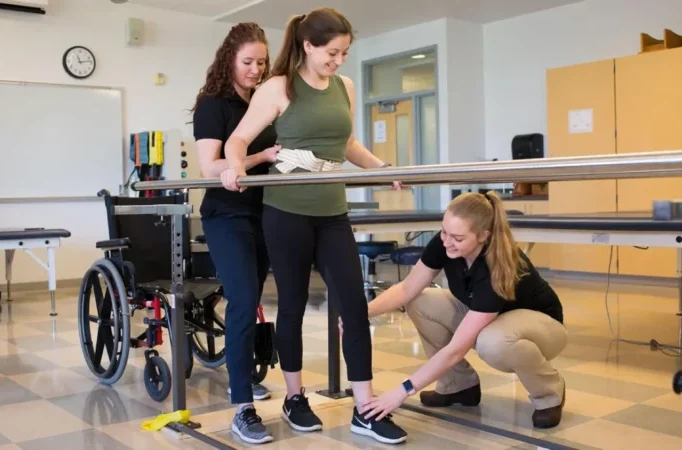A laminectomy is a surgical procedure primarily aimed at relieving pressure on the spinal cord or nerves. This operation involves removing a portion of the vertebral bone, known as the lamina. Many patients who undergo this procedure often have questions about their recovery, especially concerning the timeline for resuming activities like walking.
This blog post delves into the journey from undergoing a laminectomy to regaining full mobility, emphasizing the importance of understanding the recovery process, particularly in terms of walking capabilities after the surgery.
The Purpose of a Laminectomy
Laminectomies are performed to alleviate discomfort and symptoms caused by pressure on the spinal cord or nerves. This pressure can result from various conditions, including herniated discs, spinal stenosis, and other degenerative spinal disorders. These conditions often lead to symptoms such as severe pain, numbness, or weakness, severely impacting a person’s quality of life.
By removing a part of the vertebra, specifically the lamina, the surgery aims to relieve these symptoms. It’s a critical intervention for those who have not found relief through medication or other non-surgical treatments, offering a pathway to a more comfortable and active life.
Preparing for Surgery

Source: mynmchealth.org
Preparing for a laminectomy is a crucial step towards a successful outcome. Patients are typically required to undergo a series of evaluations and tests to ensure that they are fit for the surgery. This preparatory phase often includes comprehensive consultations with healthcare providers, various diagnostic tests like MRI or CT scans, and blood work to assess overall health status. It’s also a time for patients to discuss any concerns or questions they have about the surgery and recovery process.
In addition, patients might be advised to cease certain medications or adopt lifestyle changes to optimize surgical outcomes and minimize potential complications. If you’re wondering where to search for a neurosurgery clinic near me, consult with your healthcare provider for recommendations.
The Laminectomy Procedure
The laminectomy procedure entails a surgeon making an incision in the back to access the spine. Once the targeted area is reached, a portion of the bone and possibly some ligament material is removed to relieve pressure on the spinal nerves or cord. This process is delicate and requires precision to ensure only the necessary amount of bone is removed while protecting the spinal structures.
The surgery can vary in complexity and duration depending on the specific condition being treated and the number of vertebrae involved. Despite its invasive nature, advancements in surgical techniques have made laminectomies safer and more effective.
Immediate Post-Surgery Period

Source: verywellhealth.com
In the immediate aftermath of a laminectomy, patients are closely monitored in a recovery room. This period is crucial for ensuring that there are no complications, such as bleeding or infection. Pain management is a primary focus, with medications administered to keep the patient comfortable.
The initial hours and days after surgery involve rest, but also the beginning of mobilization activities under medical supervision. Patients may also receive instructions on how to perform basic movements safely, such as turning in bed, sitting up, and eventually standing, to promote recovery and reduce the risk of complications.
When Can You Get Out of Bed?
Typically, patients are encouraged to get out of bed within a day or two after a laminectomy. This early mobilization is a critical component of the recovery process. It’s essential to follow medical advice during this phase to balance rest and activity.
Nurses or physical therapists usually assist patients during their first few attempts to stand and walk. These initial steps are taken cautiously, with support, to ensure safety and gauge the patient’s ability to bear weight and maintain balance.
The Role of Physical Therapy

Source: pacificu.edu
Physical therapy plays a pivotal role in recovery from a laminectomy. It typically starts soon after surgery and is key in helping patients regain strength and mobility. A physical therapist will guide patients through specific exercises tailored to their individual needs and recovery goals.
These exercises aim to improve flexibility, strengthen the muscles supporting the spine, and enhance overall mobility. Regular physical therapy sessions, coupled with exercises performed at home, are instrumental in ensuring a smooth and efficient recovery.
Walking After a Laminectomy
The timeline for walking after a laminectomy varies among individuals, but patients generally start taking short, guided walks a few days post-surgery. Initially, these walks are short and slow, focusing on maintaining good posture and balance.
Gradually, the distance and duration of walking can be increased as the patient gains strength and confidence. It’s important to adhere to the guidance of healthcare professionals and not rush this process, as overexertion can lead to setbacks in recovery.
Common Challenges in Walking

Source: nextavenue.org
Patients recovering from a laminectomy may face challenges such as pain, fatigue, or difficulty in maintaining balance while walking. It’s crucial to recognize these challenges and address them appropriately. Pain can be managed with medications prescribed by the doctor, while fatigue can be countered by gradually increasing activity levels and allowing for adequate rest.
For balance issues, physical therapy can provide exercises that specifically target balance and coordination. Additionally, using assistive devices like a walker or cane, at least initially, can provide extra support and safety.
Monitoring Progress
Regular follow-up appointments with the doctor are essential for monitoring progress after a laminectomy. During these check-ups, the doctor will assess healing, evaluate any lingering symptoms, and adjust the recovery plan as needed.
Patients should be mindful of the signs of successful recovery, such as reduced pain, improved mobility, and the ability to perform daily activities with greater ease. It’s also important to report any unusual symptoms or concerns to the doctor promptly.
Returning to Normal Activities
Returning to normal activities after a laminectomy is a gradual process. The general timeline for resuming daily tasks varies, but patients can typically start to reintegrate into their normal routines within a few weeks to months after the surgery.
It’s vital to approach this process with patience and caution, gradually increasing activities and adhering to medical advice. Patients should avoid strenuous activities or heavy lifting until cleared by their healthcare provider.
Conclusion
Walking after a laminectomy is a significant milestone in the recovery journey. While the timeline and experience vary for each individual, understanding the process and following medical guidance are key. This journey demands patience, perseverance, and a positive outlook. With proper care and rehabilitation, patients can look forward to regaining their mobility and returning to their daily lives with renewed strength and hope.







